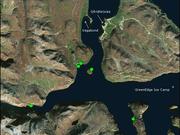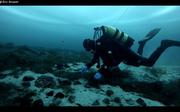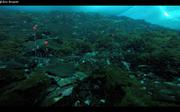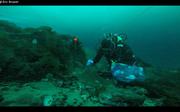Spat Sampling around Qikiqtarjuaq
In August of 2015 the Memorial University Marine Habitat Mapping Group Scientific Dive Team collected Mya spp. clams around Qikiqtarjuaq, NU in order to obtain information on their size, age, and reproductive capacity. Adult clams can be picked from the seabed by hand, but juveniles (called “spat”) can be hard to see and even harder to grab! In order to sample these juveniles, we installed spat traps in five locations in the area in sets of three, to be retrieved at different times in the following year. It turns out that spat like to settle on artificial grass, so we staked 50x50 cm artificial grass mats to seabed in the hopes that the spat will collect on top, and so that they could be easily collected.
After 7-8 months Eric and his assistant conducted SCUBA dives under the ice in frigid waters to retrieve the first set of traps, which were frozen for storage. It was extremely hard work, but Eric’s team was able to dive at each sample location and retrieve the grass mats from the seabed. We plan to bring these frozen traps back to the lab to see if any spat are present, and if they so, count and identify them. We plan to do another collection later in the year and expect to see differences in what settles on the traps between seasons, since clams usually spawn in the summer. There is little knowledge of the life cycle and population of clams in this area; through this work we hope to gain some understanding on what areas spat like to settle in, and how many settle at a given time. This is part of a larger project to assess the clam population around Qikiqtarjuaq, and map out where the best clam habitat exists in the area. This work is in support of the ongoing clam fishery assessment around Qikiqtarjuaq being conducted by the Government of Nunavut Fisheries and Sealing Division in partnership with the Memorial University of Newfoundland Habitat Mapping Group.
Ben Misiuk, PhD Student
Memorial University of Newfoundland




